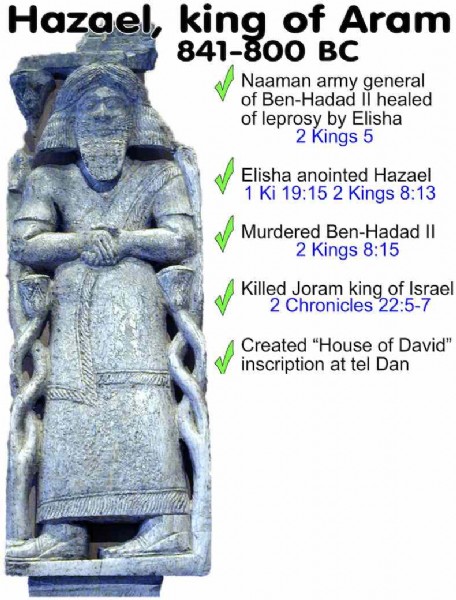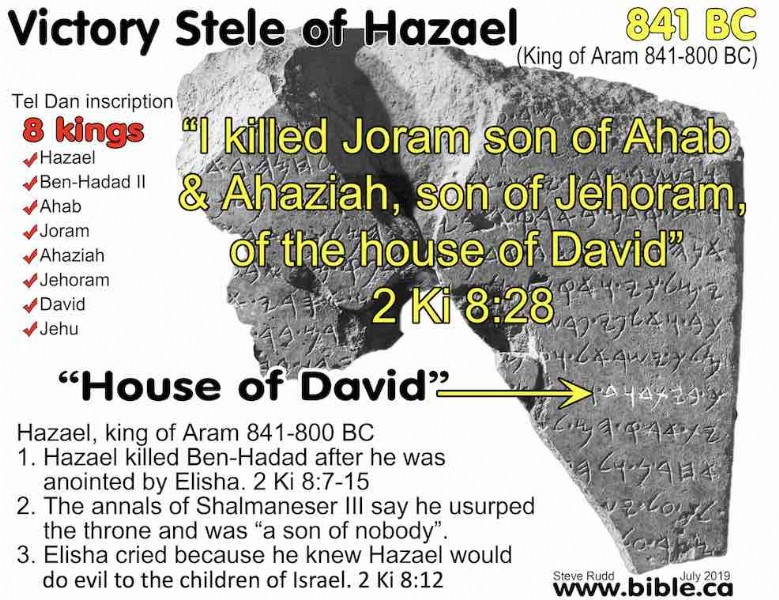Few Biblical archaeology discoveries stirred as much excitement as the Tel Dan inscription — writing on a 9th century B.C. stone slab (or stela) that furnished historical evidence of King David from the Bible. Israeli archaeologist Avraham Biran discovered the artifact in 1993 at the site of Tel Dan in northern Israel.
The broken, fragmentary inscription commemorates the victory of an Aramean king over his two southern neighbors: the ‘king of Israel’ and the ‘king of the House of David.’ In the carefully incised text written in neat Aramaic characters, the Aramean king boasts that he, under the divine guidance of the god Hadad, vanquished several thousand Israelite and Judahite horsemen and charioteers before personally executing both of his royal opponents.
 Epigrapher Christopher Rollston writes in Bible Odyssey: “Unfortunately, the recovered fragments do not preserve the names of the specific kings involved in this brutal encounter. However, based on the historical content of this inscription, plus Meso-potamian and biblical sources, the most convincing con-clusion is that the king of Damascus (Syria) known as Hazael (see annotated photo art, right) commissioned it in the ninth century B.C., after he usurped the throne of Damascus from Ben Hadad (2Ki 8:7,15). Hazael subsequently formed an alliance (1Ki 19:17, 2Ki 9:14) with king Jehu of Israel (reigned 843–815 B.C.E.), who was also a usurper. Therefore, it comes as no surprise that the Bible (2Ki 9) states Jehu of Israel slew both king Jehoram of Israel (849–843 B.C.E.) and king Ahaziah of Judah (843 B.C.E.), whereas the Tel Dan Inscription attributes these royal assassinations to Hazael. That is, these two usurpers were working together and so both could legitimately claim to have been responsible for the coup d’etat.”
Epigrapher Christopher Rollston writes in Bible Odyssey: “Unfortunately, the recovered fragments do not preserve the names of the specific kings involved in this brutal encounter. However, based on the historical content of this inscription, plus Meso-potamian and biblical sources, the most convincing con-clusion is that the king of Damascus (Syria) known as Hazael (see annotated photo art, right) commissioned it in the ninth century B.C., after he usurped the throne of Damascus from Ben Hadad (2Ki 8:7,15). Hazael subsequently formed an alliance (1Ki 19:17, 2Ki 9:14) with king Jehu of Israel (reigned 843–815 B.C.E.), who was also a usurper. Therefore, it comes as no surprise that the Bible (2Ki 9) states Jehu of Israel slew both king Jehoram of Israel (849–843 B.C.E.) and king Ahaziah of Judah (843 B.C.E.), whereas the Tel Dan Inscription attributes these royal assassinations to Hazael. That is, these two usurpers were working together and so both could legitimately claim to have been responsible for the coup d’etat.”
Within its 13 partial lines, the Tel Dan inscription stunningly aligns with the Bible, naming eight kings of that period, and corroborating Elisha’s prophecies of Hazael’s rise to the throne as well as his victory over Israel (see annotated photo art, below). Yet what makes the Tel Dan inscription one of the most exciting archaeology discoveries to scholars and laymen alike is its clear reference to the ‘House of David.’ The stela’s fragmented inscription, first read and translated by the renowned epigrapher Joseph Naveh, proved that king David from the Bible was a genuine historical figure and not simply the fantastic literary creation of post-exilic writers. Most biblical scholars and archaeologists readily accept that the Tel Dan stela supplies concrete proof of the historic King David, making it a top biblical archaeology discovery.

Sources: Biblical Archaeology Review, June 14, 2022, and Bible Odyssey, Oct. 2022. Annotated photo art from Steve Rudd at Bible.ca.
Like this? Consider sharing it to Facebook by clicking the linked icon below.
